Kyoto, with its hundreds of temples and gardens, was the imperial capital between 794 and 1868, and remains the cultural centre of Japan. Its raked pebble gardens, sensuously contoured temple roofs and mysterious Shintō shrines fulfill the Japanese fantasy of every Western cliché hunter.With an astonishing 1600 Buddhist temples, 400 Shintō shrines, a trio of palaces, and dozens of gardens and museums, Kyoto is Japan's cultural treasure house. Seventeen of Kyoto's ancient structures and gardens have been declared UNESCO World Heritage sites.
Kyoto is a sightseer's paradise. It is virtually a living museum of Japan's great artistic heritage. To explore it on foot, at least in each general area, is an intriguing and rewarding experience that creates unforgettable memories. Further, sightseeing is facilitated by the original basic grid pattern in which the city was first laid out. But whichever way you choose to view the treasures of Kyoto, you will never see enough - and never be disappointed.
Some of Kyoto's famous tourist attractions are as follows:
1. Nijo Castle
Nijo Castle (二条城, Nijōjō) was built in 1603 as the Kyoto residence of Tokugawa Ieyasu, the first shogun of the Edo Period (1603-1867). His grandson Iemitsu completed the castle's palace buildings 23 years later and further expanded the castle by adding a five story castle keep.
After the Tokugawa Shogunate fell in 1867, Nijo Castle was used as an imperial palace for a while before being donated to the city and opened up to the public as a historic site. Its palace buildings are arguably the best surviving examples of castle palace architecture of Japan's feudal era, and the castle was designated a UNESCO world heritage site in 1994.
Nijo Castle can be divided into three areas: the Honmaru (main circle of defense), the Ninomaru (secondary circle of defense) and some gardens that encircle the Honmaru and Ninomaru. The entire castle grounds and the Honmaru are surrounded by stone walls and moats.
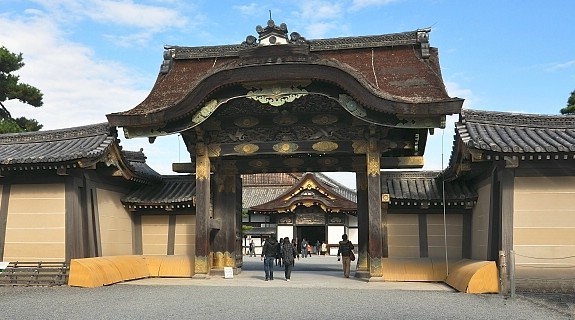
Karamon Gate
Visitors to Nijo Castle enter the castle grounds through a large gate in the east. English audio guides are available for rent (500 yen) at a kiosk just inside the gate. Venturing further into the castle will bring you to the Chinese style Karamon Gate, the entrance to the Ninomaru (secondary circle of defense), where the castle's main attraction, the Ninomaru Palace is located.
The Ninomaru Palace served as the residence and office of the shogun during his visits to Kyoto. Surviving in its original form, the palace consists of multiple separate buildings that are connected with each other by corridors with so called nightingale floors, as they squeak when stepped upon as a security measure against intruders. The palace rooms are tatami mat covered and feature elegantly decorated ceilings and beautifully painted sliding doors (fusuma).
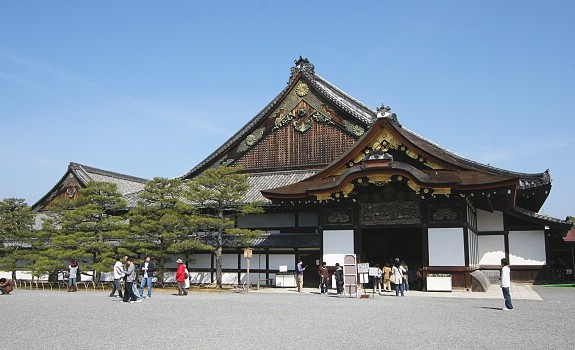
Ninomaru Palace
The tour route passes by multiple waiting and audience rooms. Only the highest ranked visitors were allowed all the way into the main audience room where the shogun would sit on an elevated floor, flanked by bodyguards hidden in closets. Lower ranked visitors would be allowed only as far as the adjoining rooms without direct view of the shogun. The innermost rooms consisted of offices and living chambers, the latter of which were only accessible to the shogun and his female attendants.
Outside of the Ninomaru Palace extends the Ninomaru Garden, a traditional Japanese landscape garden with a large pond, ornamental stones and manicured pine trees

Ninomaru Garden
The Honmaru (main circle of defense) was the site of a second palace complex and a five story castle keep. However, both structures were destroyed by fires in the 18th century and were never rebuilt. After the fall of the shogunate, an imperial residence was moved from the Katsura Imperial Palace to Nijo Castle's Honmaru where it remains today as the Honmaru Palace.
Unlike the Ninomaru Palace, the Honmaru Palace is not regularly open to the public, although there are occasional special openings. Visitors may, however, walk around the Honmaru gardens and climb up the stone foundation of the former castle keep, which offers views over the castle grounds.
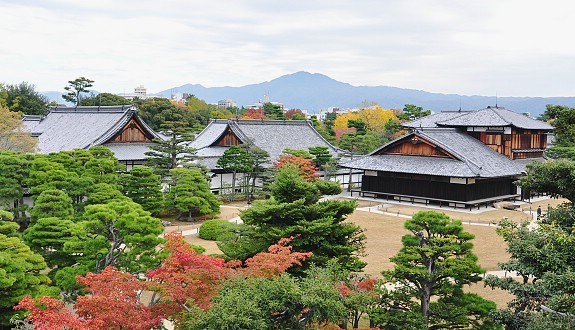
Honmaru
The Honmaru and Ninomaru are surrounded by green space and tree lined walking paths. Cherry trees of numerous varieties are planted throughout the castle grounds, including nearly 400 cherry trees of late blooming varieties in a cherry orchard. Because of the many cherry tree varieties present, the blooming season at Nijo Castle usually lasts from late March through the entire month of April.
The castle also features a plum orchard, which is typically in bloom from late February to early March, and Seiryuen, a half Japanese, half Western style garden built in 1965 for cultural events such as tea ceremonies. Many areas of the castle grounds are also populated by maple, ginkgo and other trees that offer brilliant autumn colors usually during the second half of November.
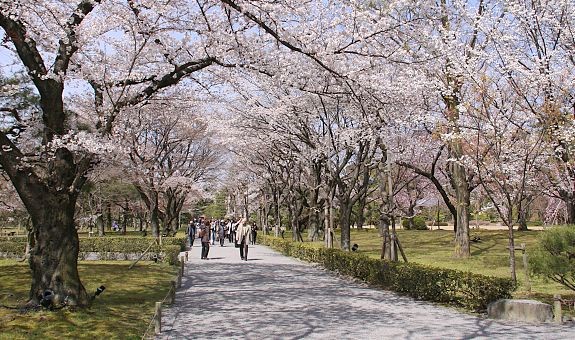
Nijojo during the cherry blossom season
2. Kyoto Railway Museum
The Kyoto Railway Museum was opened in April 2016 by JR West on the former site of the Umekoji Train and Locomotive Museum, about a twenty minute walk west of Kyoto Station. It is is one of Japan's three great railway museums alongside JR East's Railway Museum in Saitama and JR Central's SCMAGLEV and Railway Park in Nagoya.
Covering three floors on a 30,000 square meter site, the museum exhibits a total of 53 retired trains, from steam locomotives to more recent electric trains and shinkansen. Visitors can also walk underneath and observe the inner workings of a retired freight locomotive.
The museum displays railway uniforms, tools and an abundance of other appurtenances from past eras and boasts one of Japan's largest dioramas, in which miniature trains are controlled single-handedly by a skilled operator as they traverse the intricately detailed landscape. There are also a variety of interactive exhibitions where visitors can perform the duties of a train conductor or drive a train simulator. The museum's restaurant is on the second floor directly below an observation deck. Both offer nice views of the passing trains along the JR Kyoto Line and Tokaido Shinkansen.

Diorama
Next to the main building lies a roundhouse with turntable from 1914. The roundhouse showcases Japan's largest collection of well-preserved steam locomotives. Visitors can also observe real time through windows as trains are worked on in a maintenance hall built exclusively for steam locomotives. For an additional fee of 300 yen, patrons can take a one kilometer journey on a train powered by a steam locomotive that lasts around ten minutes.
At the museum's exit stands the Nijo Station Building, a picturesque, old-fashioned building relocated from nearby Nijo Station in 1997. The building was originally erected in 1904, making it the oldest of its kind in Japan and redolent of a bygone era before the widespread incorporation of concrete into train station construction
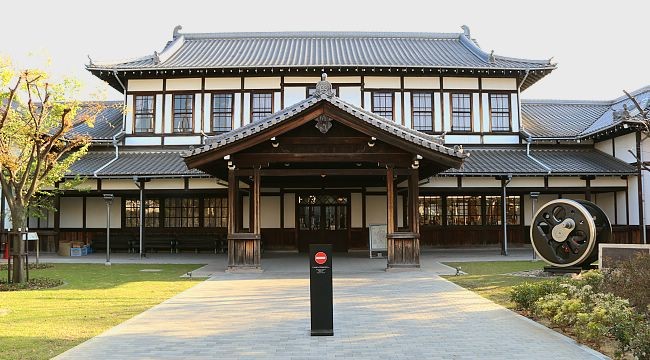
Nijo Station Building
3. Sento Imperial Palace
Sento Imperial Palace (仙洞御所, Sentō Gosho) is a secondary palace complex across from the Kyoto Imperial Palace in Kyoto Imperial Park. It was built in 1630 as the retirement palace of Emperor Gomizuno, and became the palace for subsequent retired emperors.
The original palace buildings burned down in 1854 and were not rebuilt. Instead, Omiya Palace was constructed on the Sento grounds in 1867 and now serves as the lodging place for the current prince and princess during their visits to Kyoto.
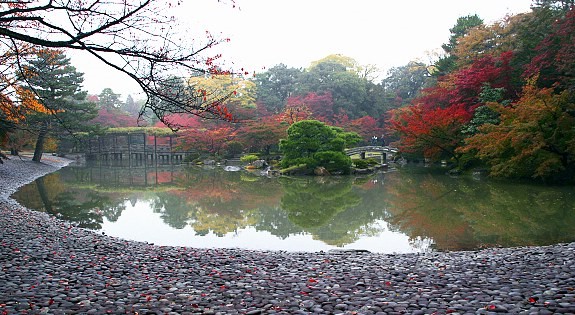
The palace garden's South Pond
Visiting Sento Imperial Palace requires joining a free tour by the Imperial Household Agency, which manages all the Imperial properties. The tour leads through the Sento garden which is comprised of the North Pond and South Pond areas. It is a beautiful example of a strolling garden.
Tours of Sento Palace last about one hour and are conducted in Japanese only. Audio guides in several foreign languages are available. None of the palace buildings are entered, however, some of the structures, such as the Seikatei teahouse, are left open so that visitors can see inside and get an impression of imperial design and style.
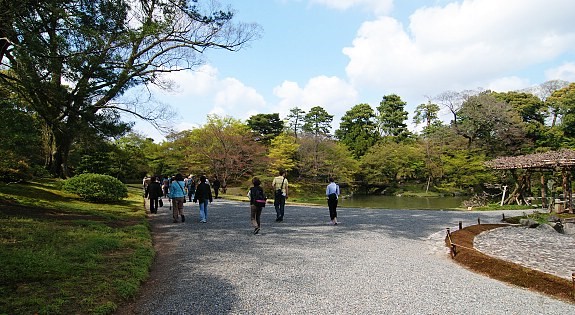
A tour group is led through the palace garden
4. Nishiki Market

Nishiki Market (錦市場, Nishiki Ichiba) is a narrow, five block long shopping street lined by more than one hundred shops and restaurants. Known as "Kyoto's Kitchen", this lively retail market specializes in all things food related, like fresh seafood, produce, knives and cookware, and is a great place to find seasonal foods and Kyoto specialties, such as Japanese sweets, pickles, dried seafood and sushi
Nishiki Market has a pleasant but busy atmosphere that is inviting to those who want to explore the variety of culinary delights that Kyoto is famous for. The stores found throughout the market range in size from small narrow stalls to larger two story shops. Most specialize in a particular type of food, and almost everything sold at the market is locally produced and procured

Some of the shops freely give out samples or sell sample dishes and skewers meant to be eaten then and there. There are also a few small restaurants and food stands selling ready-made food. A few are sit-down establishments, although some consist of no more than a couple of stools and a bar. They usually specialize in one type of food, and are often attached to a store of the same specialty
The market has a history of several centuries, and many stores have been operated by the same families for generations. It all started as a fish wholesale district, with the first shop opening around 1310. A larger variety of shops moved in later, and the area changed from a wholesale market to retail. Today it remains an important market for Kyoto and is often packed with locals and tourists alike

5. Kyoto Imperial Palace
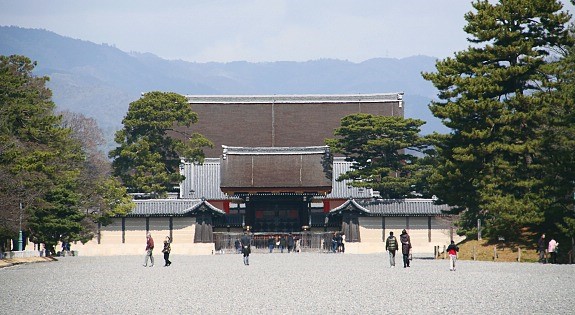
The Kyoto Imperial Palace (京都御所, Kyōto Gosho) used to be the residence of Japan's Imperial Family until 1868, when the emperor and capital were moved from Kyoto to Tokyo. It is located in the spacious Kyoto Imperial Park (京都御苑, Kyōto Gyoen), an attractive park in the center of the city that also encompasses the Sento Imperial Palace and a few other attractions.
The current Imperial Palace was reconstructed in 1855 after it had burnt down and moved around town repeatedly over the centuries. The complex is enclosed by long walls and consists of several gates, halls and gardens. The enthronement ceremonies of Emperors Taisho and Showa were still held in the palace's main hall. Tokyo Imperial Palace is now used for enthronement ceremonies.
Formerly only accessible on guided tours that required advance reservations, the palace grounds can now be entered and explored without joining a tour and without any prior arrangements (although tours in English are still available). Visitors can see the the palace buildings and gardens, but note that none of the buildings can be entered.

The Hall of State Ceremonies within the Kyoto Imperial Palace
Besides the Imperial Palace and the Sento Palace grounds, a few other historic sites are located within Kyoto Imperial Park, including the Kaninnomiya Mansion, a former residence of court nobles that is open to the public in the park's southwestern corner. Not far away stands a small branch shrine of Miyajima's famous Itsukushima Shrine on a small island of a pond.
The 1300 meter long and 700 meter wide park also serves as recreational space for both tourists and residents, featuring attractive, broad gravel paths, lawns and tree groves. A pretty group of weeping cherry trees stands beside Konoe Pond in the park's northwestern corner and is usually in bloom for two to three weeks from late March to mid April.
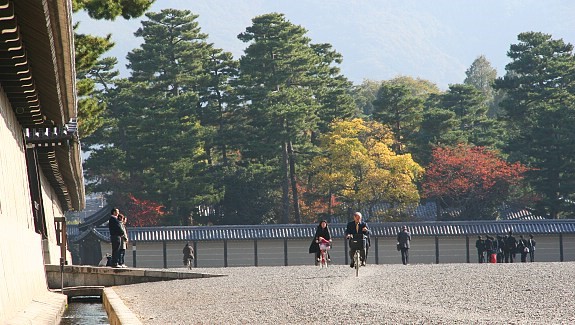
People walk and cycle along the gravel paths of
the Kyoto Imperial Park
6. Pontocho
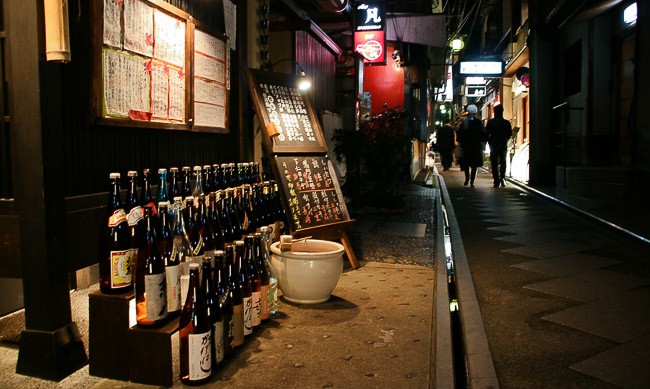
Restaurant entrances along Pontocho
Pontocho (先斗町, Pontochō) is one of Kyoto's most atmospheric dining areas. It is a narrow alley running from Shijo-dori to Sanjo-dori, one block west of Kamogawa River. The alley is packed with restaurants on both sides offering a wide range of dining options from inexpensive yakitori to traditional and modern Kyoto cuisine, foreign cuisine and highly exclusive establishments that require the right connections and a fat wallet.
Business hours and closing days of the restaurants, bars and shops along Pontocho vary by establishment, but most places are usually open from around 17:00 to 23:00. Some also open for lunch. An increasing number of establishments offer English menus.
Most of the restaurants along the eastern side of the alley overlook Kamogawa River. From May to September, many of them build temporary platforms over the flowing water where patrons can dine out in the open air. Known as kawayuka, this type of dining was developed as a way to beat the summer heat and is a great way to try some traditional Kyoto cuisine while taking in the cooling effects of the flowing water and the lively summer atmosphere. Advance reservations for kawayuka are recommended especially on Fridays and Saturdays.
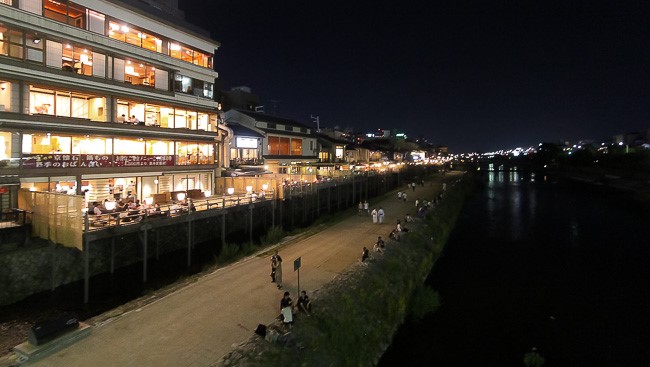
Kawayuka along Kamogawa River
If authors have visa, immigration preparation and other questions can consult the flowing people.
LIU YITING
Address: 588-12D, Yingkou Road, Yangpu District, Shanghai, P.R.China
TEL:021-5589-9932 /136-7168-0611
MAIL:liuyiting@isowa.cn





